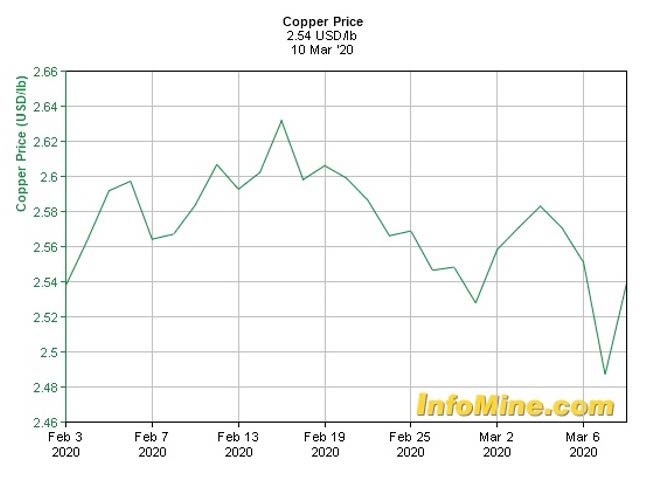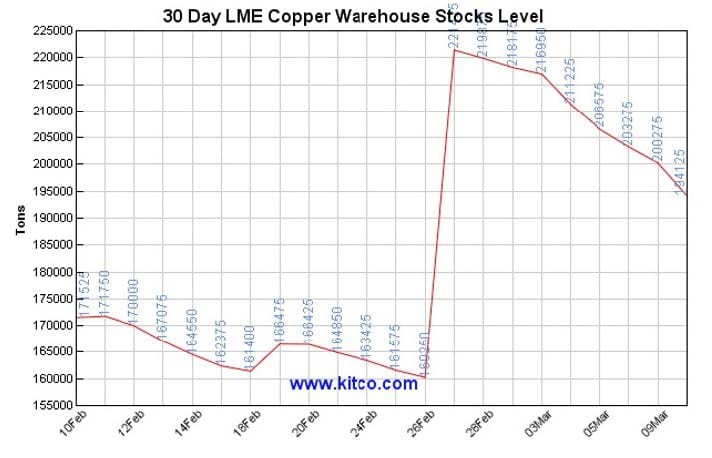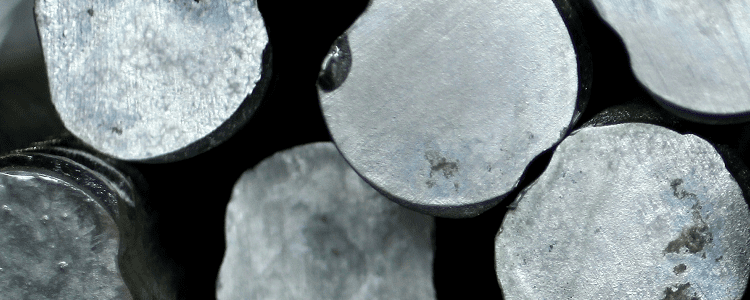Base metals are relatively common in the earth’s crust, and less expensive and easier to mine than precious metals. However, while the prices of, say, copper and nickel, are lower than silver and gold, base metals play an extremely important role in the world economy due to their many industrial applications.
“When trade impediments are solved and the viral outbreak is contained, we can expect copper prices to burst, like releasing a coiled spring.”
Copper is utilized in so many industries, such as construction, transportation, and telecommunications, it has become a leading indicator of economic growth. Its ability to predict future economic conditions has earned it a “PhD in economics”, hence its nickname “Dr. Copper”.
To wit: if demand for copper is growing and prices are rising, usually the economy is improving. Conversely, falling copper prices signal a warning that economic activity is slowing in areas such as homebuilding.
Base metals are non-ferrous, meaning they do not contain iron. All base metals except copper tarnish, oxide, or corrode relatively quickly when exposed to air or moisture. The most common base metals are copper, lead, nickel, tin, aluminum, and zinc.
While copper carries the most weight in terms of importance to the global economy, aluminum is the most-traded base metal on the London Metal Exchange (LME). The lightweight metal is extremely malleable; it can be pressed into sheets and made into containers for food and other products.
Zinc is the fourth most used metal today in terms of annual tonnage produced. Zinc’s main function is to galvanize metals. Adding a zinc coating to steel or iron protects it against rusting. A high percentage of steel that goes into buildings and automobiles is galvanized with a zinc coating, making it a
highly prized metal.
Zinc is also frequently used in die-casting, is a common ingredient in coins, and has applications in construction, including pipes and roofing.
The majority of the world’s zinc deposits contain lead, meaning lead and zinc are often mined together. The zinc mineral sphalerite is usually associated with galena (the lead mineral) and chalcopyrite (a copper mineral).
Nickel’s biggest use, about 65 percent, is in alloying, particularly with chromium and other metals to produce stainless and heat-resistant steels. More recently, nickel sulfate powder (made from nickel sulfide ore) has become a crucial ingredient in cathodes for lithium-ion batteries, needed to propel electric vehicles.
Copper Shortage Looming
As the third most-consumed metal on earth behind iron ore and aluminum, copper is all around us. Found naturally in the earth’s crust, copper was among the first metals used by early humans, dating back to the 8th century BC.
Copper is an essential metal needed for the functioning of a modern economy and for the clean, green economy of the future, which includes electric vehicles (EVs), smart grids, and 5G networks. EVs contain about four times as much copper as regular vehicles.
Just under half of copper demand is from the electronics industry. The rest is used to feed a range of industrial machinery, vehicles, and consumer products. For most, no other raw material can be substituted for copper.
Copper is useful for electrical applications because it is an excellent conductor of electricity, and cheaper than gold or silver (also both conductors). That, combined with its corrosion resistance, ductility, malleability, and ability to work in a range of electrical networks, makes it ideal for wiring. Among the
electrical devices that use copper are computers, televisions, circuit boards, semiconductors, microwaves, and fire prevention sprinkler systems.
In telecommunications, copper is used in wiring for local area networks (LAN), modems, and routers. While aluminum is preferred for overhead power transmission lines, copper wires are used in medium-voltage distribution and low-voltage connections.
The construction industry would not exist without copper; it is essential for wiring in residential and commercial structures. The red metal is also used for potable water and heating systems due to its ability to resist the growth of water-borne organisms, as well as its resistance to heat corrosion.
The transportation industry is reliant on copper for core components of aeroplanes, trains, cars, trucks, and boats. A commercial airliner has up to 190 kilometers of copper wiring, while high-speed trains use up to 10 tonnes of copper per kilometer of track. Automobiles have used copper and brass radiators and oil coolers since the 1970s. Most new vehicles need copper for on-board navigation, anti-lock braking systems, heated seats, defrosting wires embedded in windows, hydraulic lines, and wiring for window and mirror controls.
China is by far the largest copper consumer, every year receiving around half of the world’s copper shipments.
China’s Belt and Road Initiative (BRI) envisions a vast network of railways, pipelines, highways, and ports that extend west through the mountainous former Soviet republics and south to Pakistan, the Middle East, India, and southeast Asia. Research by the International Copper Association found that the BRI is likely to increase demand for copper in over 60 Eurasian countries to 6.5 million tonnes by 2027, a 22 percent increase from 2017.
According to a report by McKinsey Global Institute, general copper demand could grow to 31 million tonnes by 2035, a 43 percent increase from today’s 22 million tonnes (Mt).
Total mined production in 2019 was just 20Mt, according to the US Geological Survey.
How to bridge the gap? The problem is that existing copper mines aren’t able to crank out as much production needed to ensure that all the demand bases are covered. Additionally, without major new mines up and running to replace the ore that is being depleted from existing copper mines, the industry is looking at a 15-million-tonne supply deficit by 2035.
Some of the largest copper mines are seeing their reserves dwindle and are having to dramatically slow
production due to major capitalintensive projects to move operations from open pit to underground Copper grades are declining, making mining more expensive, especially in Chile, the world’s number one producer.
The copper “pipeline” is the lowest it’s been in a century, and not improving. New supply is concentrated in just five mines – Chile’s Escondida, Spence, Quebrada Blanca, Cobre Panama, and Kamoto in the DRC. Both countries are prone to resource nationalism, with Chile suffering the social effects of stark inequality, and the DRC government seen as unstable and rife with corruption. In 2018 the DRC raised taxes and royalties on copper and cobalt – of which the Congo is the top producer – amid fierce opposition from miners.
Exploration for new copper deposits that are large and high-grade enough to be economically brought into production is therefore of primary importance to the mining industry; especially since the demand side of the equation, despite the current lull in China’s GDP growth, is only going to get stronger.
Outlook
There’s no denying that the base metals complex has suffered from the coronavirus and the unresolved US China trade war, but we expect these to be temporary phenomena. For copper, all it means is a delay in the inevitable copper surge that is coming. When trade impediments are solved and the viral outbreak is contained. we can expect copper prices to burst, like releasing a coiled spring.
There is optimism that daily case numbers in China, the epicenter of the virus, are dropping.
One base metals trader quoted in the Financial Post believed that, in China, the worst was over. An analyst at CRU Group noted the utilization rate at copper semi fabricators (makers of wire-rod or tubes) has picked up. Chinese factories are slowly coming back online, raising hopes of an uptick in
copper demand. Consider too, copper supply appears to be tightening. The level of copper stocks in London Metal Exchange warehouses sank from over 220,000 tons on February 26th, to about 195,000t on March 9th.
For the short term, the outlook for copper is good. In a new report, Fitch analysts revised their 2020 copper price upward by USD 200 per tonne, from USD 5,700 to USD 5,900, writing that they expect
increased stimulus from the Chinese government to raise copper prices in the second half of the year.
We believe that once the trade war is resolved and the coronavirus outbreak is contained (we know it will likely get worse before it gets better but there is already light at the end of the tunnel), copper’s bullish fundamentals will be the cream that rises to the top of the base metals complex.


Legal Notice / Disclaimer
Ahead of the Herd newsletter, aheadoftheherd.com, hereafter known as AOTH.
Please read the entire Disclaimer carefully before you use this website or read the newsletter. If you do not agree to all the AOTH/Richard Mills Disclaimer, do not access/read this website/ newsletter/article, or any of its pages. By reading/using this AOTH/Richard Mills website/ newsletter/article, and whether or not you actually read this Disclaimer, you are deemed to have accepted it.
Any AOTH/Richard Mills document is not, and should not be, construed as an offer to sell or the solicitation of an offer to purchase or subscribe for any investment.
AOTH/Richard Mills has based this document on information obtained from sources he believes to be reliable but which has not been independently verified. AOTH/Richard Mills makes no guarantee, representation or warranty and accepts no responsibility or liability as to its accuracy or completeness. Expressions of opinion are those of AOTH/Richard Mills only and are subject to change without notice. AOTH/Richard Mills assumes no warranty, liability or guarantee for the current relevance, correctness or completeness of any information provided within this Report and will not be held liable for the consequence of reliance upon any opinion or statement contained herein or any omission. Furthermore, AOTH/Richard Mills assumes no liability for any direct or indirect loss or damage or, in particular, for lost profit, which you may incur as a result of the use and existence of the information provided within this AOTH/Richard Mills Report.
AOTH/Richard Mills is not a registered broker/financial advisor and does not hold any licenses. These are solely personal thoughts and opinions about finance and/or investments – no information posted on this site is to be considered investment advice or a recommendation to do anything involving finance or money aside from performing your own due diligence and consulting with your personal registered broker/financial advisor. You agree that by reading AOTH/Richard Mills articles, you are acting at your OWN RISK. In no event should AOTH/Richard Mills liable for any direct or indirect trading losses caused by any information contained in AOTH/Richard Mills articles. Information in AOTH/Richard Mills articles is not an offer to sell or a solicitation of an offer to buy any security. AOTH/Richard Mills is not suggesting the transacting of any financial instruments but does suggest consulting your own registered broker/ financial advisor with regards to any such transactions.












